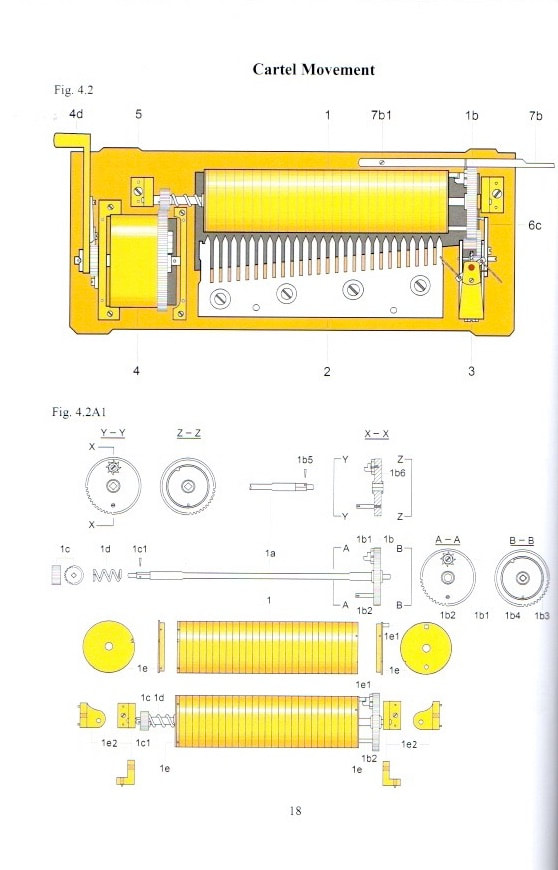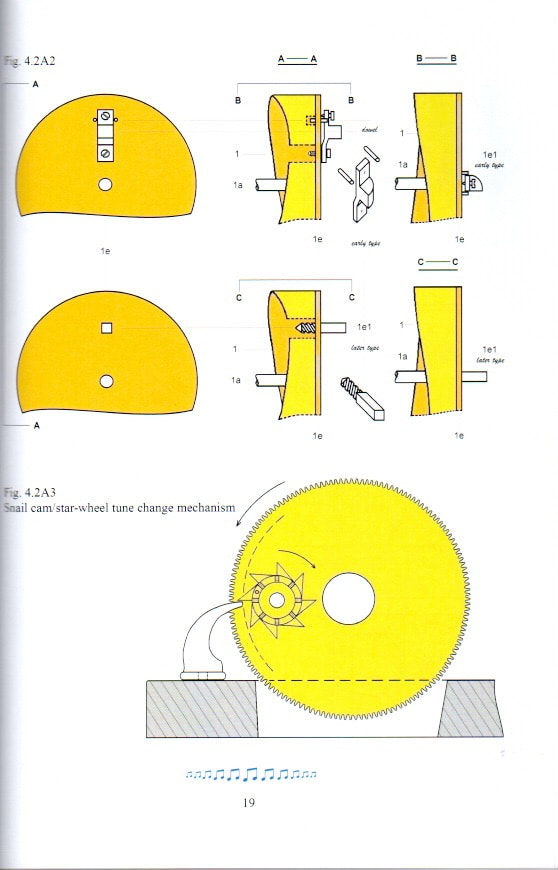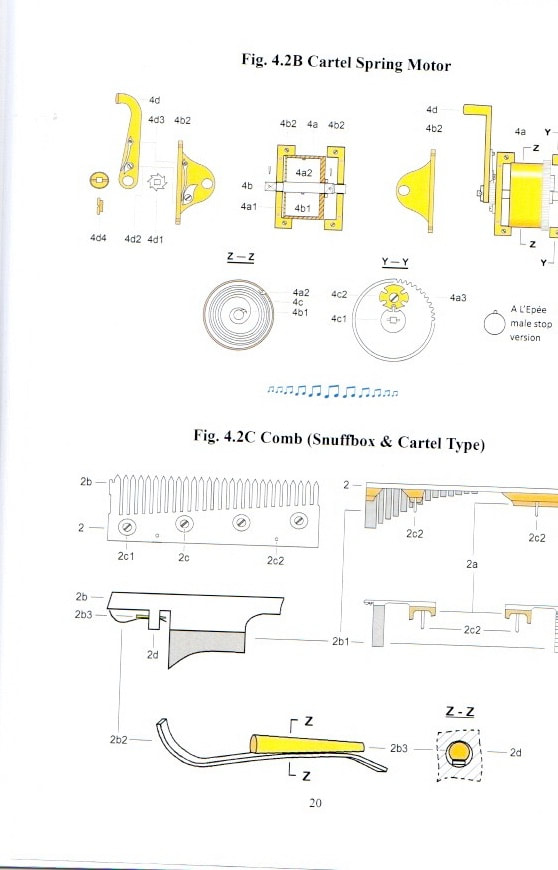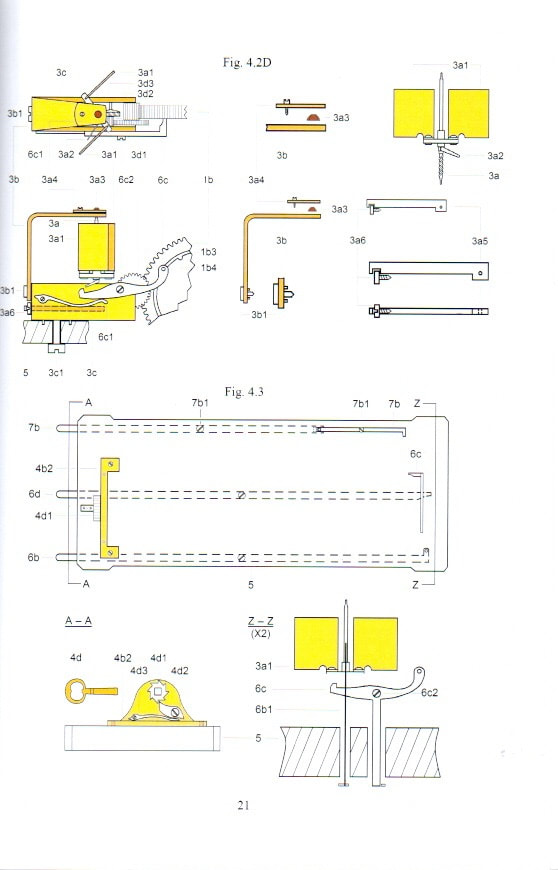A Short History of Cylinder Music Boxes
Definition
“A musical box is an automatic musical instrument that produces sound when the pins on a revolving cylinder, or disc, pluck the teeth of a steel comb.”
History
Before the Musical Box came along the only way that anyone could listen to a piece of music was to attend a concert. Musical Boxes were the first method by which music could be played back at will.
The earliest models were small enough to be enclosed in a pocket watch, seal or signet ring and often made of gold, with mechanisms known as ‘sur plateau’ movements. The teeth were plucked by a rotating pinned disc or short pinned cylinder called a ‘barillet’ and housed in elaborate and costly cases.
Movements gradually increased in size and complexity with longer cylinders and sections of steel teeth fixed side by side to form a single length comb. Later the groups of teeth were made from one piece of steel.
The smaller movements were usually fitted into ‘snuff boxes’ or ‘tabatieres’, designed to fit into a gentleman’s waistcoat pocket. The boxes were often ornately decorated or made of tortoise shell and precious metals, but many were fitted into simple tin boxes with a printed scene on the lid. Later in the 19th century these movements were also being fitted inside photograph albums, sewing boxes and all manner of merchandise.
Music boxes varied greatly in size, but many were tabletop specimens – some were so large that they stood on the floor.
The first music box factory was opened in Switzerland in 1815 by Jérémie Recordon and Samuel Junod. Other manufacturers were found in Bohemia and Germany. By the end of the 19th Century some European makers had opened factories in the United States.
The ingenuity of the makers saw no bounds. Some movements had exceptionally long cylinders with over 100 notes and played 30 or more tunes. Some had interchangeable cylinders to expand the melodies available, others included bells, drums and other percussion. Some even had bellows and ‘organ’ pipes.
Some exceptional models had four springs and could play for up to three hours.
The musical Box phenomenon only lasted just over 100 years until Edison invented the phonograph and brought recorded music to a price that could be afforded by most people.
The earliest models were small enough to be enclosed in a pocket watch, seal or signet ring and often made of gold, with mechanisms known as ‘sur plateau’ movements. The teeth were plucked by a rotating pinned disc or short pinned cylinder called a ‘barillet’ and housed in elaborate and costly cases.
Movements gradually increased in size and complexity with longer cylinders and sections of steel teeth fixed side by side to form a single length comb. Later the groups of teeth were made from one piece of steel.
The smaller movements were usually fitted into ‘snuff boxes’ or ‘tabatieres’, designed to fit into a gentleman’s waistcoat pocket. The boxes were often ornately decorated or made of tortoise shell and precious metals, but many were fitted into simple tin boxes with a printed scene on the lid. Later in the 19th century these movements were also being fitted inside photograph albums, sewing boxes and all manner of merchandise.
Music boxes varied greatly in size, but many were tabletop specimens – some were so large that they stood on the floor.
The first music box factory was opened in Switzerland in 1815 by Jérémie Recordon and Samuel Junod. Other manufacturers were found in Bohemia and Germany. By the end of the 19th Century some European makers had opened factories in the United States.
The ingenuity of the makers saw no bounds. Some movements had exceptionally long cylinders with over 100 notes and played 30 or more tunes. Some had interchangeable cylinders to expand the melodies available, others included bells, drums and other percussion. Some even had bellows and ‘organ’ pipes.
Some exceptional models had four springs and could play for up to three hours.
The musical Box phenomenon only lasted just over 100 years until Edison invented the phonograph and brought recorded music to a price that could be afforded by most people.
Timeline
9th century: The oldest known mechanical musical instrument was invented in Baghdad by the Banū Mūsā brothers, a trio of Persian inventors. It was a hydropower organ which played interchangeable cylinders automatically, as they described in their Book of Ingenious Devices.
In early 13th century in Flanders, an ingenious bell ringer at St Catherine’s Abbey nr Rouen invented a cylinder with pins which operated cams which then hit bells – a form of Carillon but the Musical box as we know it was probably not invented until around 1770 in Switzerland.
1598: Flemish clockmaker Nicholas Vallin produces a wall-mounted clock which has a pinned barrel playing on multiple tuned bells mounted in the superstructure. The barrel can be programmed, as the pins can be separately placed in the holes provided on the surface of the barrel.
1665: Ahasuerus Fromanteel in London makes a table clock which has quarter striking and musical work on multiple bells operated by a pinned barrel. These barrels can be changed for those playing different tunes.
1760s: Watches are made in London by makers such as James Cox which have a pinned drum playing popular tunes on several small bells arranged in a stack.
1772: A watch is made by one Ransonet at Nancy, France which has a pinned drum playing music not on bells but on tuned steel prongs arranged vertically.
1780: The mechanical singing bird is invented by the Jaquet-Droz brothers, clockmakers from La Chaux-de-Fonds. In 1848, the manufacturing of the singing birds is improved by Blaise Bontems in his Parisian workshop, to the point where it has remained unchanged to this day. Barrel organs become more popular.
1796: Antoine Favre-Salomon, a clockmaker from Geneva patented the first cylindrical music box that had a metal comb with tuned teeth. This replaced the stack of bells by a comb with multiple pre-tuned metallic notes in order to reduce space. Together with a horizontally placed pinned barrel, more varied and complex sounds could be produced. One of these first music boxes is now displayed at the Shanghai Gallery of Antique Music Boxes and Automata in Pudong's Oriental Art Center. Numerous musical objects are produced in greater quantities in Geneva by several makers.
1800: Isaac Daniel Piguet in Geneva produces repeating musical watches with a pinned horizontal disc operating radially arranged tuned steel teeth.
1811: The first music boxes are produced in Sainte-Croix; an industry which surpasses the watchmaking and lace industries, and rapidly brings renown to the town. At this time, the musical-box industry represents 10% of Switzerland's export.
1865: Charles Reuge, a watchmaker from the Val-de-Travers, settles in Sainte-Croix. He is one of many artisans making pocket watches with musical movements of the traditional calibre.
1870: A German inventor creates a music box with discs, therefore allowing an easier and more frequent change of tunes. It is also the golden years of automata. Already known in Egypt, they will be improved to become real works of art.
1877: Thomas Edison invents the phonograph, which has important consequences for the musical-box industry, especially around the end of the century.
1892: Gustave Brachhausen, who had been involved with the manufacturer of Polyphon disk music boxes in Germany, sails for America to establish the Regina Music Box Company in New Jersey. Regina, whose boxes are renowned among collectors for their tone, becomes a success and some 100,000 are sold before sales ceased in 1921.
Early 20th century: The invention of the phonograph, the First World War and the economic crisis in the '20s bring down Sainte-Croix's main industry and make the luxury music box completely disappear.
The only remaining manufacture of Music Boxes in Sainte Croix is Reuge who only make extraordinary pieces that are way out of reach of all but the super rich.
In early 13th century in Flanders, an ingenious bell ringer at St Catherine’s Abbey nr Rouen invented a cylinder with pins which operated cams which then hit bells – a form of Carillon but the Musical box as we know it was probably not invented until around 1770 in Switzerland.
1598: Flemish clockmaker Nicholas Vallin produces a wall-mounted clock which has a pinned barrel playing on multiple tuned bells mounted in the superstructure. The barrel can be programmed, as the pins can be separately placed in the holes provided on the surface of the barrel.
1665: Ahasuerus Fromanteel in London makes a table clock which has quarter striking and musical work on multiple bells operated by a pinned barrel. These barrels can be changed for those playing different tunes.
1760s: Watches are made in London by makers such as James Cox which have a pinned drum playing popular tunes on several small bells arranged in a stack.
1772: A watch is made by one Ransonet at Nancy, France which has a pinned drum playing music not on bells but on tuned steel prongs arranged vertically.
1780: The mechanical singing bird is invented by the Jaquet-Droz brothers, clockmakers from La Chaux-de-Fonds. In 1848, the manufacturing of the singing birds is improved by Blaise Bontems in his Parisian workshop, to the point where it has remained unchanged to this day. Barrel organs become more popular.
1796: Antoine Favre-Salomon, a clockmaker from Geneva patented the first cylindrical music box that had a metal comb with tuned teeth. This replaced the stack of bells by a comb with multiple pre-tuned metallic notes in order to reduce space. Together with a horizontally placed pinned barrel, more varied and complex sounds could be produced. One of these first music boxes is now displayed at the Shanghai Gallery of Antique Music Boxes and Automata in Pudong's Oriental Art Center. Numerous musical objects are produced in greater quantities in Geneva by several makers.
1800: Isaac Daniel Piguet in Geneva produces repeating musical watches with a pinned horizontal disc operating radially arranged tuned steel teeth.
1811: The first music boxes are produced in Sainte-Croix; an industry which surpasses the watchmaking and lace industries, and rapidly brings renown to the town. At this time, the musical-box industry represents 10% of Switzerland's export.
1865: Charles Reuge, a watchmaker from the Val-de-Travers, settles in Sainte-Croix. He is one of many artisans making pocket watches with musical movements of the traditional calibre.
1870: A German inventor creates a music box with discs, therefore allowing an easier and more frequent change of tunes. It is also the golden years of automata. Already known in Egypt, they will be improved to become real works of art.
1877: Thomas Edison invents the phonograph, which has important consequences for the musical-box industry, especially around the end of the century.
1892: Gustave Brachhausen, who had been involved with the manufacturer of Polyphon disk music boxes in Germany, sails for America to establish the Regina Music Box Company in New Jersey. Regina, whose boxes are renowned among collectors for their tone, becomes a success and some 100,000 are sold before sales ceased in 1921.
Early 20th century: The invention of the phonograph, the First World War and the economic crisis in the '20s bring down Sainte-Croix's main industry and make the luxury music box completely disappear.
The only remaining manufacture of Music Boxes in Sainte Croix is Reuge who only make extraordinary pieces that are way out of reach of all but the super rich.
Anatomy
- The bedplate is the relatively heavy metal foundation on which all the other pieces are fastened, usually by screws.
- The ratchet lever or the windup key is used to put the spring motor under tension, which is to wind it up.
- The spring motor or motors (two or more can be used to make playing times longer) give anywhere from a few minutes to an hour or more of playing time.
- The comb is a flat piece of metal with dozens or even hundreds of tuned teeth, or 'reeds', of different lengths.
- The cylinder is the programming object, a metallic version of a punched card which instead of having holes to express a program, is studded with tiny pins at the correct spacing to produce music by displacing the teeth of the comb at the correct time. The tines of the comb 'ring', or sound, as they slip off the pins. The disc in a disc music box plays this function, with pins perpendicular to the plane surface.
- Multiple-tune cylinders have more than one set of pins intertwined on the same cylinder, with, for example, the B pins for a second song lying halfway between the B and C pins of the first song, etc. Offsetting the cylinder slightly relative to the comb brings the different set of pins into contact with the teeth, thereby playing an alternate piece of music. Many modern music boxes will have as many as four sets of pins intertwined, with a mechanism automatically shifting the cylinder from one song or movement to the next.
These drawings show an 'exploded' Cylinder Box. Click an image for a larger view.
(Drawing published with the permission of the author, Paul Bellamy)
Visit any of the Workshop diaries for more information and photos




